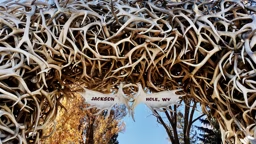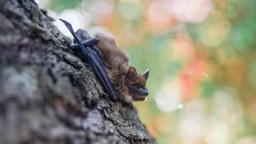Very early one warm, August morning, Georgeann Hall woke her daughter in the adjacent bedroom of their weekend cabin. She thought she had just seen a black bear in the kitchen. Her daughter said she must have been dreaming, and Hall began to think so, too – until she caught a glimpse of the bear opening the refrigerator and helping itself to the Log Cabin syrup.
The two women barricaded themselves inside the bedroom, where they considered their options. “We needed to call for help,” Hall recalls. The phone, however, was in the kitchen with the 900-pound bear. So they crawled out the bedroom window and escaped to their car. Luckily, the keys were in the ignition.
After driving to the nearest pay phone, they called the police. Officer Mark Pope followed them back to the cabin where he fired his hunting rifle into the air and scared the bear out of the cabin.
What attracted the bear to their Wisconsin cabin in the first place? Quite probably, the scent of food in the form of freshly baked cookies from the previous evening.
“It was one of those perfect nights,” Hall says, “and so we left the windows and the door to the screened porch open.” The bear pried the screen off the door frame and was rewarded with fresh cookies and other treats. Not a bad payoff.
“We came to call it the Gourmet Bear,” Hall says.
The two women barricaded themselves inside the bedroom, where they considered their options. “We needed to call for help,” Hall recalls. The phone, however, was in the kitchen with the 900-pound bear. So they crawled out the bedroom window and escaped to their car. Luckily, the keys were in the ignition.
After driving to the nearest pay phone, they called the police. Officer Mark Pope followed them back to the cabin where he fired his hunting rifle into the air and scared the bear out of the cabin.
What attracted the bear to their Wisconsin cabin in the first place? Quite probably, the scent of food in the form of freshly baked cookies from the previous evening.
“It was one of those perfect nights,” Hall says, “and so we left the windows and the door to the screened porch open.” The bear pried the screen off the door frame and was rewarded with fresh cookies and other treats. Not a bad payoff.
“We came to call it the Gourmet Bear,” Hall says.
Confrontations on the Rise
More and more often, black bears and humans are running into each other. A recent study by the International Association of Fish and Wildlife Agencies (IAFWA) shows the bear population in North America has increased 12 percent over the last five years. And this is happening as humans increasingly build in areas that were once part of the wild kingdom. As a result, the number of bear complaints has risen 19 percent, the study shows.
Eric Wenum, biologist for the state of Montana’s Fish, Wildlife and Parks is something of a black bear expert. He works in an area bordering Glacier National Park, a region containing one of the highest black bear densities in the nation – about one bear per square mile.
On average, Wenum will receive 1,300 complaints a year about bears or bear damage.
“As prime bear habitat becomes increasingly settled by humans, we’re bringing all kinds of things with us: trash, bird feeders, pet food, greasy barbeques. Once they’ve associated food with houses, they’re likely to return. It works very much like a reward system.”
Wenum continues: “If you have a neighbor who intentionally feeds deer, or leaves pet food out, a lot of times that creates a neighborhood problem. Bears don’t necessarily differentiate between one house and another. They learn that houses in general have food. But they may end up at one that doesn’t have any. And if he can’t find the food, he might escalate his behavior and start testing doors and windows.”
So although a homeowner may be doing everything right by eliminating bear attractants on his property, he can still be at risk because of a neighbor who isn’t.
Can you Teach a Bear New Tricks?
Laws regarding bear relocation or destruction vary from state to state, and sometimes from county to county. Most agencies will kill or move a bear only as a last resort. Wenum uses Karelian bear dogs to deter bears from returning. The dogs will tree the bears or scare them away with their barking.
But trying to modify a bear’s behavior is difficult once a bear becomes accustomed to finding food. It’s better if humans don’t provide food sources in the first place.
When Hall and her daughter were checking out the cabin later that morning, another surprise awaited them. A perfect bear paw print was on the side of the cabin just outside their bedrooms. Their close call had been even closer than they thought.
The bear never returned but, Georgeann says, “Now we close all the windows and doors.”
Freelance writer Jennifer Hawks owns a cabin in the Yukon and often pilots small airplanes from which she can see bears at a very safe distance.
More and more often, black bears and humans are running into each other. A recent study by the International Association of Fish and Wildlife Agencies (IAFWA) shows the bear population in North America has increased 12 percent over the last five years. And this is happening as humans increasingly build in areas that were once part of the wild kingdom. As a result, the number of bear complaints has risen 19 percent, the study shows.
Eric Wenum, biologist for the state of Montana’s Fish, Wildlife and Parks is something of a black bear expert. He works in an area bordering Glacier National Park, a region containing one of the highest black bear densities in the nation – about one bear per square mile.
On average, Wenum will receive 1,300 complaints a year about bears or bear damage.
“As prime bear habitat becomes increasingly settled by humans, we’re bringing all kinds of things with us: trash, bird feeders, pet food, greasy barbeques. Once they’ve associated food with houses, they’re likely to return. It works very much like a reward system.”
Wenum continues: “If you have a neighbor who intentionally feeds deer, or leaves pet food out, a lot of times that creates a neighborhood problem. Bears don’t necessarily differentiate between one house and another. They learn that houses in general have food. But they may end up at one that doesn’t have any. And if he can’t find the food, he might escalate his behavior and start testing doors and windows.”
So although a homeowner may be doing everything right by eliminating bear attractants on his property, he can still be at risk because of a neighbor who isn’t.
Can you Teach a Bear New Tricks?
Laws regarding bear relocation or destruction vary from state to state, and sometimes from county to county. Most agencies will kill or move a bear only as a last resort. Wenum uses Karelian bear dogs to deter bears from returning. The dogs will tree the bears or scare them away with their barking.
But trying to modify a bear’s behavior is difficult once a bear becomes accustomed to finding food. It’s better if humans don’t provide food sources in the first place.
When Hall and her daughter were checking out the cabin later that morning, another surprise awaited them. A perfect bear paw print was on the side of the cabin just outside their bedrooms. Their close call had been even closer than they thought.
The bear never returned but, Georgeann says, “Now we close all the windows and doors.”
Freelance writer Jennifer Hawks owns a cabin in the Yukon and often pilots small airplanes from which she can see bears at a very safe distance.
Bear Encounters
• If you do encounter a bear, slowly but deliberately back away.
• With black bears, it is recommended that you make a lot of noise while retreating. Shouting is a good deterrent to prevent them from following you.
• Never run from any bear as this may encourage it to chase you; and bears run much faster than we do. (I once saw a young woman run toward a bear because she was excited to see it. This isn’t recommended, either!)
• If you’re inside the house with a bear, seek protection in a room with a locked door.
How to Avoid Attracting Bears
Bears are omnivores so they’ll eat anything. The key is awareness: What humans might consider inedible, bears may find irresistible. Some tips:
• Don’t leave your trash outside. It may not contain much food, but the odor is an attractant.
• Bird feeders contain highly nutritious food that bears crave. Replace the feeders with a birdbath, or string the feeder a minimum of 10 feet above the ground, and four feet out from the trunk or any tree branch. A pulley system can make the feeder available to you, but not the bear.
• If you must feed a pet outside, don’t leave the food or food bowl outside. Even metal containers retain food odors.
• After an outdoor meal, remove all food traces before moving on to the next activity. If you decide to “deal with it later,” a bear might just take care of it for you.
• Pick fruit or berries near your cabin as soon as they’re ripe. Rake the area clean of dropped fruit or nuts. Fermenting fruit is particularly attractive to bears.
• Keep first-floor doors and windows closed and locked. If you think it will get too warm, consider metal grills over windows and doors.
• Keep your barbeque and grilling implements clean of food residues and grease, brushes included. If you can’t store the barbeque inside, cover it.
• Be mindful of what you put in the compost bin. Under no circumstances should you put fruit, meat, fish or dairy products in the compost.
• Promptly dispose of any dead bird, squirrel or other animal carcass.
Bears are omnivores so they’ll eat anything. The key is awareness: What humans might consider inedible, bears may find irresistible. Some tips:
• Don’t leave your trash outside. It may not contain much food, but the odor is an attractant.
• Bird feeders contain highly nutritious food that bears crave. Replace the feeders with a birdbath, or string the feeder a minimum of 10 feet above the ground, and four feet out from the trunk or any tree branch. A pulley system can make the feeder available to you, but not the bear.
• If you must feed a pet outside, don’t leave the food or food bowl outside. Even metal containers retain food odors.
• After an outdoor meal, remove all food traces before moving on to the next activity. If you decide to “deal with it later,” a bear might just take care of it for you.
• Pick fruit or berries near your cabin as soon as they’re ripe. Rake the area clean of dropped fruit or nuts. Fermenting fruit is particularly attractive to bears.
• Keep first-floor doors and windows closed and locked. If you think it will get too warm, consider metal grills over windows and doors.
• Keep your barbeque and grilling implements clean of food residues and grease, brushes included. If you can’t store the barbeque inside, cover it.
• Be mindful of what you put in the compost bin. Under no circumstances should you put fruit, meat, fish or dairy products in the compost.
• Promptly dispose of any dead bird, squirrel or other animal carcass.
 Tanya Nygren
Tanya Nygren  Karen Noyce, Minnesota Department of Natural Resources
Karen Noyce, Minnesota Department of Natural Resources  Karen Noyce, Minnesota Department of Natural Resources
Karen Noyce, Minnesota Department of Natural Resources 









